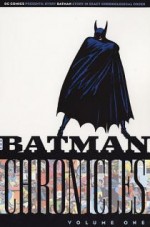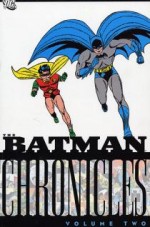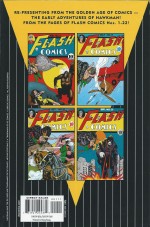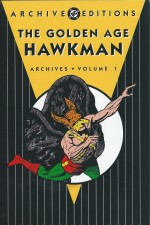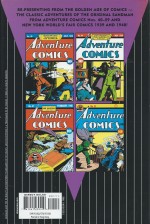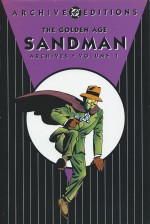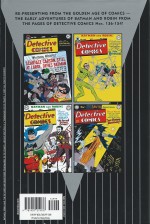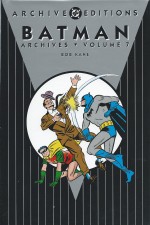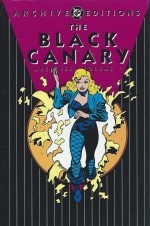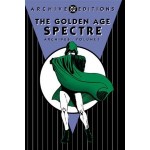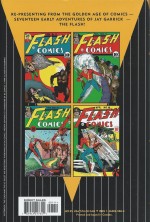
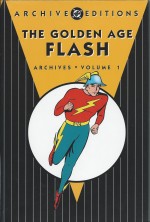
By Gardner F. Fox, Harry Lampert, E.E. Hibbard, Hal Sharp & various (DC Comics)
ISBN: 978-1-4012-0784-7
The innovative fledgling company that became DC published the first comicbook super-speedster and over the decades has constantly added more to its pantheon of stars. Devised, created and written by Gardner Fox and first realised by Harry Lampert, Jay Garrick debuted as the very first Monarch of Motion in Flash Comics #1 and quickly – of course – became a veritable sensation.
“The Fastest Man Alive†wowed readers of anthologies like Flash Comics, Comics Cavalcade, All Star Comics and other titles – as well as solo vehicle All-Flash Quarterly – for just over a decade before changing tastes benched him and most other first-generation costumed heroes in the early1950s.
His invention as a strictly single-power superhero created a new trend in the burgeoning action-adventure funnybook marketplace, and his particular riff was specifically replicated many times at various companies where myriad Fast Furies sprang up such as Johnny Quick , Hurricane, Silver Streak, the Whizzer, Quicksilver and Snurtle McTurtle, the Terrific Whatzit amongst so many others…
After half a decade of mostly interchangeable cops, cowboys and cosmic invaders, the concept of human speedsters and the superhero genre in general was spectacularly revived in 1956 by Julie Schwartz in Showcase #4 when police scientist Barry Allen became the second hero to run with the concept. We’ve not looked back since – and if we did it would all be a great big blur…
This oddly beguiling deluxe Archive edition collects the first year and a half – January 1940 to May 1941 – of the irrepressible Garrick’s whimsically eccentric exploits in seventeen (regrettably untitled) adventures from the anthology Flash Comics, revealing
an appealing rawness, light-hearted whimsy and scads of narrative experimentation in the tales of brilliant nerd but physical sad-sack who became a social crusader and justice-dispensing human meteor.
Following a fulsome Foreword from contemporary Flash scribe Mark Waid, the fast fictions begin with his very first appearance as ‘The Fastest Man Alive’ which speedily delivered in a mere 15 pages an origin, introduced a returning cast and a carried out a classic confrontation with a sinister gang of gangsters.
It all started some years previously when college student Garrick passed out in the lab at MidwesternUniversity, only to awaken hyper-charged and the fastest creature on Earth thanks to the “hard water fumes†he had inhaled whilst unconscious.
After weeks recovering in hospital, the formerly-frail apprentice chemist realised the exposure had given him super-speed and endurance, so he promptly sought to impress his sort-of girlfriend Joan Williams by becoming an unstoppable football player…
Time passed, the kids graduated and Garrick moved to New York where, appalled by the rampant crime, he decided to do something about it. The Flash operated mostly in secret until one day, whilst idly playing tennis with himself, Jay met Joan again, just as mobsters tried to kill her in a drive-by shooting.
Catching the bullets, Jay gets reacquainted with his former paramour and discovers that she is a target of criminal combine the Faultless Four, master criminals set on obtaining her father’s invention the Atomic Bombarder. In the blink of an eye Flash has crushed the sinister schemes of the gang and their diabolical leader Sieur Satan, saving Joan’s life whilst revelling in the sheer liberating fun and freedom of being gloriously unstoppable…
In his second appearance The Flash stumbled upon a showgirl’s murder and discovered that yankee mobster Boss Goll and British aristocrat Lord Donelin planned to take over the entire entertainment industry with their ruthless strong-arm tactics. The speedster was as much hindered as helped by wilful, headstrong Joan who began her own lifetime-obsession of pesky do-gooding here…
Everett E. Hibbard began his decade long association with the Flash in issue #3 when, in a rare display of continuity, Major Williams’ Atomic Bombarder became the target of foreign spies and the elderly boffin was framed for treason, once more prompting Garrick to come to his future father-in-law’s aid, after which Jay and Joan combined to smash an off-shore gambling ring which had graduated to kidnapping and blackmail in #4.
During these early adventures, the Flash seldom donned his red, blue and yellow outfit, usually operating invisibly or undercover and playing super-speed pranks with merciless, puckish glee, but that began to change in #5, when the speedster saved an elderly artist from hit-men to foil mad collector Vandal who used murder to increase the market value of his purchases.
Flash Comics #6 found Jay and Joan foiling a scheme to dope athletes trying to qualify for the Olympics at old Alma Mater Midwestern, before #7 revealed how a stopover in Duluth led to the foiling of gambler Black Mike who was fixing motorcar races with a metal melting ray. For #8, the Vizier of Velocity tracked down seemingly corrupt contractors building shoddy, dangerous buildings only to find the graft and skulduggery went much further up the financial food chain…
In issue #9, gangsters got hold of a scientist’s invention and the Flash found himself battling a brigade of giant Gila Monsters, after which #10 depicted the speedy downfall of a cabal of politicians in the pocket of gangster Killer Kelly and stealing from the schools they administered, whilst in #11, Garrick met his first serious opponent in kidnap racketeer The Chief, whose brilliance enabled him to devise stroboscopic glasses which could track and target the invisibly fast crime-crusher…
With the threat of involvement in the “European War†a constant subject of American headlines, Flash Comics #12 (December 1940) had the heroic human hurricane intervene to save tiny Ruritanian nation Kurtavia from ruthless invasion. His spectacular lightning war saw Garrick sinking submarines, repelling land armies and crushing airborne blitzkriegs for a fairytale happy ending here, but within a year the process would become a patriotic morale booster repeated ad infinitum in every American comicbook as the real world brutally intruded on the industry and nation…
Back in the USA for #13, Garrick went to aid old friend Jim Carter in cowboy country where the young inheritor of a silver mine was gunned down by murdering owlhoots, before Jay heading back east to crush a criminal combine sabotaging city subway construction in #14 and saving a circus from robbery, sabotage and poor attendances in #15.
Throughout all these yarns Jay had paid scant attention to preserving any kind of secret identity – a fact that would soon change – but as Hal Sharp took over the illustration with #16 (Hibbard presumably devoting his energies to the contents of the forthcoming 64-page All-Flash Quarterly #1 – to be seen in the succeeding Archive collection), Joan was kidnapped by Mexican mobsters aware of her connection to The Flash.
Rushing to her rescue Garrick was forced to battle a small army, but not only saved his girlfriend but even managed to reform bandit chief José Salvez.
This first high-energy compilation ends with another light-hearted sporting escapade as the speedster intervenes in a gambling plot, saving a moribund baseball team from sabotage even as Jay Garrick – officially “almost as fast as the Flash†– becomes the Redskins’ star player to save them from lousy performances…
With covers by Sheldon Moldoff, Dennis Neville, George Storm, Jon L. Blummer, Hibbard and Sharp, this book is a sheer delight for lovers of the early Fights ‘n’ Tights genre: amazing, exciting and funny, although certainly not to every modern fan’s taste. Of course, with such straightforward thrills on show any reader with an open mind could find his opinion changed in a flash.
© 1940, 1941, 1999 DC Comics. All Rights Reserved.

